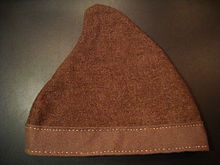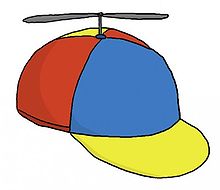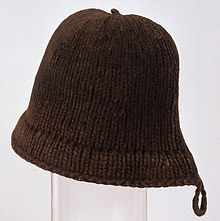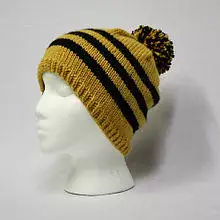A cap is a form of headgear. Caps have crowns that fit very close to the head. They made their first appearance as early as 3,200BC.[1] Caps typically have a visor, or no brim at all.[2] They are popular in casual and informal settings, and are seen in sports and fashion. [2] They are typically designed for warmth, and often incorporate a visor to block sunlight from the eyes. They come in many shapes, sizes, and are of different brands. Baseball caps are one of the most common types of cap.[3]
Types
.jpg)
German M43-style field cap of the "Bundesgrenzschutz" (BGS) (now called Bundespolizei), the German Federal Police

Phrygian cap as fashion
- Ascot cap
- Ayam
- Baggy green
- Balmoral
- Baseball cap
- Beanie (North America)
- Bearskin
- Beret
- Biretta
- Busby
- Canterbury cap
- Cap and bells
- Cap of maintenance
- Casquette
- Caubeen
- Caul
- Coif
- Combination cap (also known as a service cap)
- Coppola
- Cricket cap
- Deerstalker
- Do-rag
- Dutch cap
- Fez
- Fitted cap
- Flat cap (also known as a Kerry cap in Ireland (slang of Paddy cap – see also Caubeen), longshoreman's cap, scally cap, Wigens cap, ivy cap, golf cap, duffer cap, driving cap, bicycle cap, Jeff cap, or in Scotland, bunnet, or in Wales, Dai cap, or in England or New Zealand, cheese-cutter)
- Forage cap
- Gandhi cap
- Garrison cap
- Glengarry
- Greek fisherman's cap (also known as a Breton cap or a fiddler's cap)
- International cap
- Juliet cap
- Karakul
- Kepi
- Kippah (also known as yarmulke or skull cap)
- Knit cap (also known as a Tuque, stocking cap, wool cap, watch cap, ski cap, bobble hat)
- Kufi (also known as a kofia; an African cap worn with a dashiki)
- Lika cap
- M43 field cap
- Mao cap
- Monmouth cap
- Newsboy cap
- Nightcap
- Nurse cap
- Ochipok
- Papakhi
- Patrol cap
- Peaked cap
- Phrygian cap
- Railroad engineer cap
- Rastacap
- Sailor cap
- Shako
- Shower cap
- Sindhi cap
- Snapback
- Sports visor
- Square academic cap
- Stormy Kromer cap
- Swim cap
- Tam o' Shanter
- Taqiyah, worn by Muslim males
- Toque
- Trucker hat
- Tubeteika
- Ushanka
- Utility cover
- Zucchetto
See also
- Bonnet, until about 1700, the usual word for brimless male headgear
- Cap (sport), metaphorical term
- List of headgear
References
- ^ "Who Invented The Hat? - Amazing Hat History". Fashionable Hats. Retrieved 2020-11-17.
- ^ a b "Cap vs. Hat: Differentiating the Meaning of Different Headgear". Typing Adventure. 2019-07-26. Retrieved 2020-11-17.
- ^ "Baseball Hat & Cap History". baseball.epicsports.com. Retrieved 2020-11-17.




